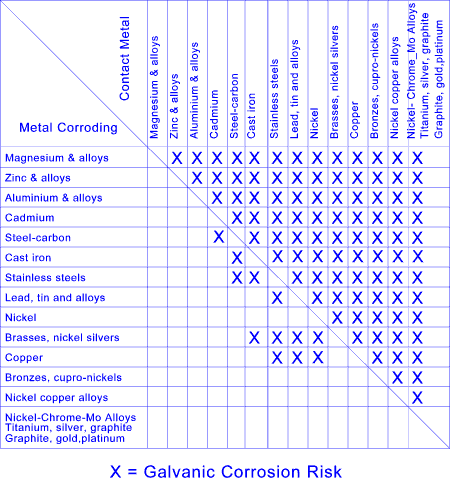Bi- Metallic Corrosion. (Galvanic
corrosion).
Bi-Metallic corrosion is the additional corrosion
that occurs when dissimilar metals are in contact in
the presence of an electrolyte. The
corrosion of a metal, the anode, results from the
positive current flowing from the anode to the less
reactive (more noble) metal, the cathode, through the
electrolyte. This process is similar to
the conventional corrosion of a single, uncoupled
metal but generally proceeds at a higher rate
depending on the difference in electrochemical
reactivity of the anode and cathode metal.
The requirements for bi-metallic corrosion are as
follows:
- An electrolyte bridging the two metals
- Electrical contact between the two metals.
- A difference in potential between the
metals to enable a significant galvanic current
- A sustained cathodic reaction on the more
noble of the two metals.
|

Electrolyte
The degree of bi-metallic corrosion is affected by
the electrolyte pH and conductivity. The intensity of
the corrosion can increase with the conductivity of
the electrolyte. Typical values of conductivity of
various fluids are listed below;
|
Distilled Water
|
0.5-2 μS/cm
|
|
Stored Distilled Water
|
2-4 μS/cm
|
|
Supply Water
|
50-1500 μS/cm
|
|
Sea Water
|
50,000 μS/cm
|
|
Sat. Sodium Chloride
|
250,000 μS/cm
|
|
Sulphuric Acid
|
up to 800,000 μS/cm
|
Bi-metallic corrosion is seldom a problem when the
metals are immersed in pure water.
Methods of Reducing Corrosion resulting from
Galvanic Corrosion
Where contact between dissimilar metals cannot be
avoided the following steps should be
considered
- Select metals that are close together in
the galvanic series for the relevant
environment
- Avoid relatively small areas of the less
noble metal and large areas of the more noble
metal
- Insulate the metals from each other
- Exclude electrolyte from around the
bimetallic junction e.g painting
- Paint both metals where possible: if
impractical paint the most noble metal
- Provide additional corrosion allowance on
the less noble metal
- Apply compatible metal or sacrificial metal
coatings
- If electrical insulation is used to
minimise the risk, then test for the insulation
quality as part of maintenance regime
|
Galvanic Series
Reference -Oxidation
-Reduction
Galvanic corrosion is driven by the voltage potential
between two electrically connected conductors
( To minimize this form of attack,
materials in electrical contact, if required, should
be selected so as to minimize their relative
potential.
The galvanic series of metals lists common materials
in order of their electrical potential relative to a
recognized standard. Materials widely
separated on this list will rapidly corrode in the
presence of electolyte (e.g. Seawater) when in
electrical contact, the anodic material suffering
rapid material loss. Materials close
together on this list will suffer less damage due to
corrosion.
-
Anodic - Least Noble
- Magnesium
- Magnesium Alloys
- Zinc
- Cadmium
- Aluminum
- Mild Steel , Wrought Iron
- Cast Iron, Low Alloy High Strength Steel
- Chrome Iron (active)
- Stainless Steel, 430 Series (active)
- Stainless Steel 302, 303, 321, 347,
410,416, (Active)
- Ni - Resist
- Stainless Steel 316, 317, (Active)
- Aluminum Bronze
- Hastelloy C (active) Inconel 625 (active)
- Titanium (active)
- Lead - Tin Solders
- Lead
- Tin
- Inconel 600 (active)
- Nickel (active)
- Hastelloy B (active)
- Brasses
- Copper
- Manganese Bronze , Tin Bronze (
- Nickel Silver
- Copper - Nickel Alloy 90-10
- Copper - Nickel Alloy 80-20
- Stainless Steel 430
- Nickel, Aluminum, Bronze
- Monel
- Silver Solder
- Nickel (passive)
- 60 Ni- 15 Cr (passive)
- Inconel 600 (passive)
- 80 Ni- 20 Cr (passive)
- Chrome Iron (passive)
- Stainless Steel 302, 303, 304, 321,
347,(PASSIVE)
- Stainless Steel 316, 317,(PASSIVE)
- Incoloy 825nickel - Molybdeum - Chromium
- Iron Alloy (passive)
- Silver
- Titanium (pass.) Hastelloy C (passive)
- Inconel 625(pass.)
- Graphite
- Zirconium
- Gold
- Platinum
-
Cathodic Most Noble.
|
|
